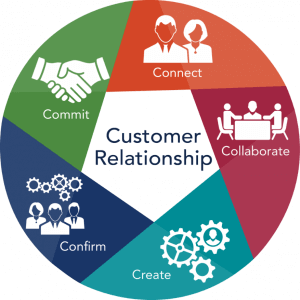Businesses remain in existence because they continue to make a profit. And they continue to make a profit through revenue from sales. And they grow sales through good people, lots of hard work, and, yes, technology.
And here’s the thing about technology. It is continually evolving and allowing organizations to improve their business processes, especially their sales functions. From data access to AI, to mobile, to social, e-signature and more, sales processes from beginning to end have been transformed. Companies that choose to embrace these new technologies will maintain a competitive edge.
Here are some of the most important technological advances, and their uses, that are transforming the sales process.
Data Analytics Tools
Oceans of data are out there for the gathering, but until recently there has been no way to gather unstructured data and then structure it in ways that make sense and allow businesses to make smarter decisions. Relative to sales, companies can have customer histories and purchasing behaviors charted and reported; they can gather information on those demographics that will make the best sales leads; they can even target individual customers based upon all of this information. What was once a human labor-intensive process is now streamlined and “served up on a platter” for the taking. Here are a couple of examples:
- As soon as a customer enters the Amazon website, AI tools begin working. As a customer browses products, all is recorded. When a purchase is made, immediately that customer is introduced to products that others like him have also bought. He has become one of a pool of customers based upon current and even past buying behaviors.
- Banks use AI to categorize their customer bases and to analyze the loan products that have been most popular with those segments. They look at past behaviors and use AI to predict the types of loan products that will be most popular in the future, even down to what seasons of the year such products may be most in demand.
Any business can be like Amazon and banks, using the current big data gathering and analytical tools now available. If only for the lead generation potential, AI should be totally in use.
Customer Relations Management (CRM)
 source
source
Research shows that it is far more profitable for businesses to keep current customers than it is to convert new ones. And even when new customers come on board, establishing quality and satisfactory relationships with them is key to keeping them.
So much of customer service can be automated today, it is a wonder that any business is not using the technology that will do this. It totally streamlines and improves account management.
- First, there are tools to segment customers and potential customers based on where they are in a sales funnel. Personalized and segmented emails can be sent out automatically, from a simple thank you for an order to specials for loyal customers, and much more.
- When consumers have common questions about products or services or commonly asked questions, such as how to return a product, there is no reason for humans to respond. This only slows down the process and frustrates the customer (can we say sitting on hold forever or waiting for a return email?). Businesses should be using chatbots infused with AI that can provide immediate responses, saving the company money and keeping consumers happy.
- Complex and larger issues (angry customers, for example) can easily be routed to a human for resolution, if companies will use the tools they have access to.
Social Listening
source
All companies know how important social media platforms are for connecting with their customers, for generating leads, for spreading their brands, and for developing relationships.
Indirect marketing is a key function of social media. Consumers rely on one another for recommendations. And every happy customer a business has on social media becomes a brand ambassador with his community.
But even more is the social listening aspect of brand and customer management. There is a myriad of software tools that will alert a business any time it is mentioned on social media, providing time, place, and actual comments. This allows a company to address any issues or negative comments, as well as respond to and express appreciation for positive mentions.
Searches/SEO
Just as social media should be monitored so should search engine. Optimization is a key goal for ultimate sales. Using highly efficient tools to research those search terms that are the most popular in a business niche and ensuring that those terms are imbedded in all copywriting improves SEO. Small businesses especially need to be aware should be very mindful of their copywriting efforts, as Google algorithms are watching closely. Content must be fresh, unique, and provide real value. Any business can use available technology to identify critical topics and write about them in engaging and compelling ways.
Globalization and Localization
Sales is now a global function, as consumers over the world have access to the web (especially through mobile devices) and the ability to purchase products from anywhere. Businesses should move into this global market, and to do so their websites and other content must be localized for foreign audiences. While this was once a laborious procedure, again, technology has simplified and streamlined this process. Machine-generated translations have become much more sophisticated, and pros who can provide these services can be found at Pick Writers, a translation review site that evaluates the performance of the top translation agencies.
Geolocation and Retail Sales
source
This technology is perhaps the most exciting for lead scoring, qualification of leads, and/or targeting potential customers where they are physical. When consumers use their mobile devices for searches or to look for products on a specific website, the location of that device can be identified in real-time. This allows for:
- Location-Based Marketing: A company can be notified if a consumer is in close proximity to one of its retail stores and then send out push notifications with offers or coupons, or even an event reminder, such as a storewide sale going on right now.
- Micro-Moment Sales: Red Roof Inn uses a combination of airline information and push notifications to grab customers in the moment. When a flight has been canceled, and consumers are on their mobile devices, they receive notification of the location of the nearest Inn and a special rate promotion. This is an example of what has come to be known as micro-moment sales – again, taking advantage of where a device I located in real-time.
- Geo-Targeted Ads: Companies can now target specific countries, regions, cities, and even zip codes to decide where to best place their ads. Google AdWords, for example, has a feature that provides income levels of consumers based upon zip codes. This gives retailers a sense of the qualification of a target audience for products they are selling. But it also allows companies to send ads to those who live within a certain number of miles within one of its locations or for locations of consumers who are potential customers.
- Improving the customer experience. Taco Bell has targeted specific audiences and has pushed the concept of ordering food in advance for pickup. It uses a chatbot to take those orders and make recommendations. But it also geo-targets that customer’s location, so that it can estimate the time of arrival, ensuring that the food is hot and ready upon arrival.
- Identifying Actual Customers, in addition to devices: This may sound a bit creepy to consumers, but the technology is now available to identify actual people to devices that are “tracked.” Retailers can then personalize a targeted ad in real-time, especially if that consumer is visiting the website of a competitor.
Technology is sweeping the world of business, and certainly sales. Only those brands that keep up and use these technologies as they come to pass will keep a competitive edge in the market place.
As we move even further into the digital age, we need to recognize the almost-universal effect that our technology is having on our businesses. Otherwise, we may find our organizations left behind. Even though we can count on technology to constantly improve, the only thing keeping individual companies and businesses from falling behind is the willingness to improve as well.








